Once Again I Will Tell You Never Tell Me How to Type
Learning how to show don't tell in writing is 1 of the most difficult—and important—parts of writing when you offset outset.
Information technology's what volition give readers the coveted emotional attachment that forges true, long-lasting fans (and customers!).
Part of writing and publishing a book successfully is ensuring yous have the highest quality writing, and this dominion of evidence don't tell is crucial for that.
When yous showtime writing a book, it's as if everyone around you becomes the adept. They tell you lot to show don't tell, start with activeness, or fifty-fifty embellish your stories to sound "better."
Simply how do yous know what communication to have…and what do those writing tips fifty-fifty mean in the first place?
Nosotros're here to aid you sympathize showing versus telling and how that volition actually help you write improve and stronger.
It's safe to say that the idea of showing not telling is i all writers should pay shut attention to.
Show don't tell in writing is a slice of advice that'southward been around for longer than yous might realize. Even if it didn't have a phrase fastened to information technology yet, the best authors out there accept been using it for the duration of their careers (and even before, virtually likely).
Hither's how to show don't tell in writing:
- Sympathise what show don't tell means
- Learn from examples of showing versus telling
- Cut the "sensing" words to show don't tell
- Avoid emotional explaining when showing not telling
- Describe body linguistic communication
- Use strong verbs to show don't tell
- Focus on describing senses
- Practise showing not telling every day
In fact, it's why they're known as the best writers of all time.
Simply although these writers knew how to bring their writing to life instinctually, not all of united states of america are so lucky. We have to learn the procedure of bear witness don't tell, which can be tricky if you lot don't know where to start.
Want to know which author yous're most like? Accept the quiz and learn more about yourself and your writing style!
What does show don't tell mean?
Evidence don't tell describes writing in various forms with an accent on using and showing deportment in order to convey the emotions yous desire readers to interpret, which creates a better experience for readers, instead of writing exposition to tell what happened.
By showing the actions and relationships and feelings instead of merely telling the reader what happened, the writing comes off deeper, and more meaningful. This creates a much deeper connection and brings readers closer to you (or the main character).
At a showtime glance, this writing dominion could exist confused for the all-time twenty-four hour period in Kindergarten when you bring your pet lizard in to evidence the form.
Simply in actuality, prove don't tell refers to the way in which you lot depict the experience yous (or your character) went through.
And that makes them feel deeper and stronger about the story. It creates empathy and invests the reader – which is exactly what you lot need .
Writing your book introduction with an abundance of showing not telling is a powerful style to draw readers in for the elapsing of your entire book.
Simply this technique is much easier shown than told (hehe – see what I did there?).
[Pssst! Desire to run into some of our Students' published books? Cheque out the SPS Library hither!]
Evidence Don't Tell Examples:
These examples are pretty bones only that'southward the best way to gain an understanding of what this looks like. Proceed in listen that your sentences may be more complex than these examples, but all the same full of "tell" words or phrases.
Be on the lookout for the details.
Show Don't Tell Case #ane:
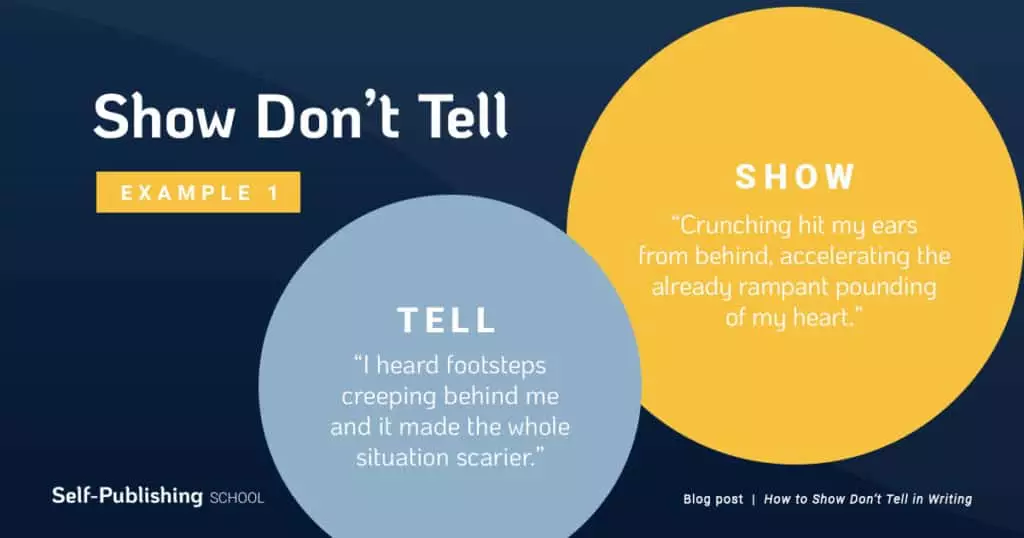
Tell: "I heard footsteps creeping behind me and information technology made the whole state of affairs scarier."
Evidence: "Crunching hit my ears from backside, accelerating the already rampant pounding of my eye."
Why this showing example is better:
In an case such as this, you lot want the reader to experience what you lot did: the surprise and the sense of urgency, the fear.
Describing the crunching that hitting your ears fifty-fifty through the pounding of your centre not but creates a powerful visual, but it too tells the reader the state your body was in during that intense moment. The offset case is weak and does little to explain how you really felt in that moment.
Show Don't Tell Case #ii:
Tell: "She was my best friend. I could tell her almost annihilation."
Show: " I met her at the boondocks foursquare, running in for our usual hug that carried on for far too long as nosotros gushed about our lives with smiles lighting our faces."
Why this showing example is better:
The first example of telling is shorter, but it doesn't do a great job of really showing the impact you have on each other. Anyone can recall of "best friend" and form an overall idea about what that looks like. Only this isn't just "anyone." This is your best friend. Showing your relationship with i another is vital to forging that deeper connection.

Why should y'all show don't tell in writing?
The unabridged indicate of showing versus telling in writing is to make a stronger emotional connectedness with your readers and hook them.
They already picked upward your volume for the killer championship and eye-grabbing cover, simply they need a reason to stay.
The idea backside this writing technique is to put the reader in your shoes. Make them feel, hear, and sense the situation as yous did.
It's about creating an experience for the reader instead of just a recount of events.
Doing this makes the reader want to root for you. They want to hear your whole story and in turn, they'll read your whole volume.
Why is showing not telling also important for non-fiction?
If you lot write fiction, you hear this advice all the time. However, all of you lot non-fiction writers out there, this piece of writing communication might be new to you.
Show don't tell isn't always the start thing a non-fiction author thinks of when information technology comes to adding more intrigue to your story.
But information technology is the almost vital for pulling your reader in and not only hooking them, but keeping them with y'all throughout the duration of your volume.
Many fiction writers hear this writing advice often because it'southward one of the all-time ways to brand real people feel securely for fictional characters.
When it comes to writing a story virtually your life and something y'all went through, the thought is the same. By showing and not telling, y'all'll exist able to guide them through your real-life situation as an experience and not just some book they're reading while the kids are yelling at their video games and the oven alarm is blaring in the distance.
If you can prove don't tell the right mode, the reader won't even notice those distractions.
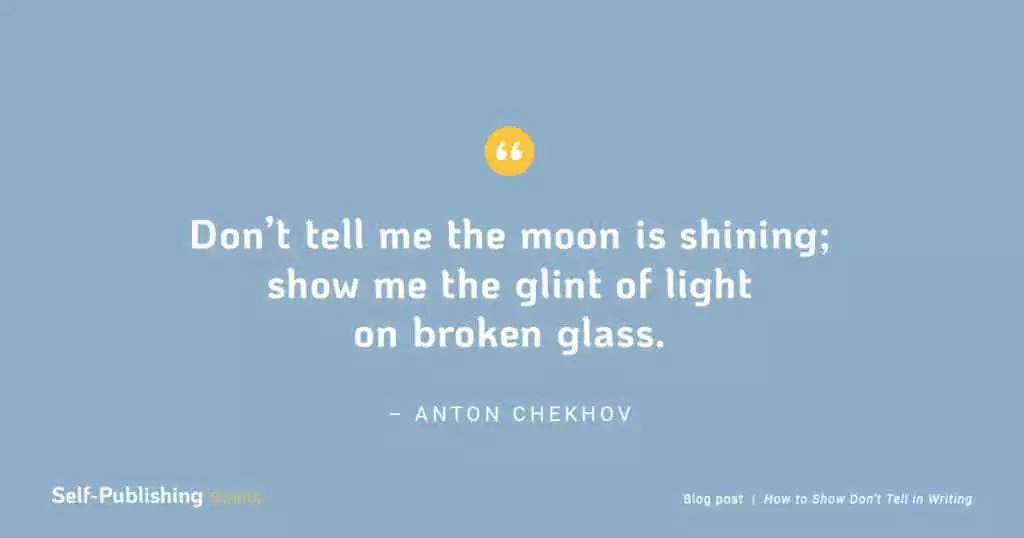
How to Testify Don't Tell in Writing
So now you know what it is and why it's of import, just how the heck do you actually do it? The procedure of taking a single story and crafting it to create more emotion can be difficult.
Thankfully, we have some of the best tips for showing not telling in writing.
#1 – Go rid of all basic sensory words
Phrases like, "I heard," "I felt," and "I smelled," are all very weak. These are "telling" words and phrases (also commonly referred to equally "filters") that force the reader further abroad from y'all and your experience.
That's exactly what you want to avoid.
Instead, you lot need to pull them into your world and into your psyche the very moment you were encountering the situation.
This is done by using strong verbs and other visual linguistic communication.
Show Don't Tell Practise #1:
Step 1: Read through your writing and circumvolve every telling word you can discover. Anything that explains one of the 5 senses.
Step two: And so write down specifics for each. If yous heard someone creeping upwards backside y'all, how did y'all hear it? Was information technology crunching on gravel? Was it the shuffling of shoes confronting carpet?
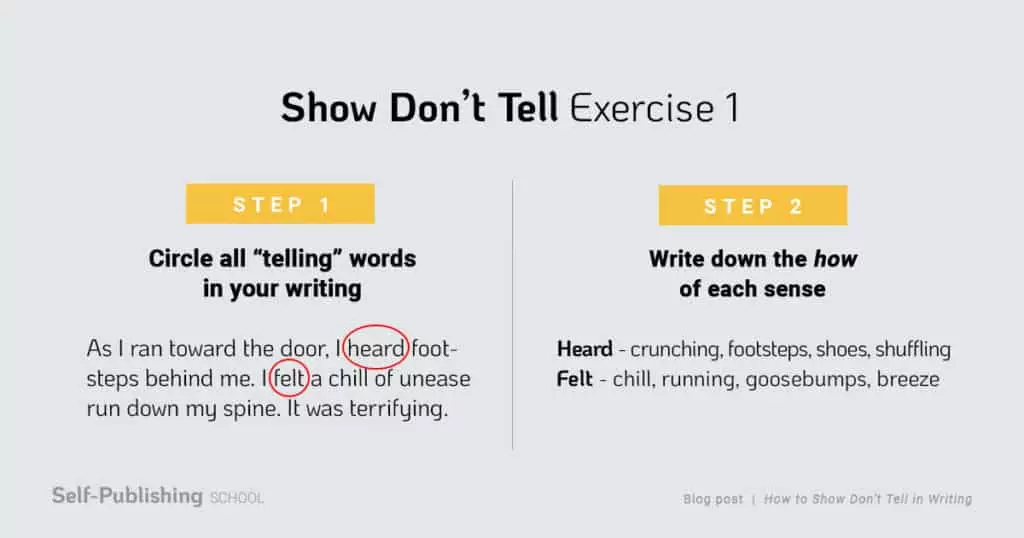
In one case you have these, rewrite those sections past explaining how the senses manifested to you lot and not just what yous sensed (detailed below in the next writing exercise).
#two – Don't utilize "emotion explaining" words
This might be a bit tricky and you certainly don't accept to follow this one 100% of the fourth dimension, but if yous can get this right, it'll make showing versus telling so much easier to grasp.
Think of whatever discussion to describe an emotion. I'll help you out a little:
- Happy
- Sad
- Angry
- Frustrated
- Excited
- Giddy
- Honey
- Broken-hearted
- Joy
- Disgust
I could keep, merely I recall you go the idea.
These are all great words to describe how someone felt. However, they're too very weak, unexciting ways to do and then.
If you need your readers to sympathise how excited you lot were at whatsoever given time, show them. Don't only tell them, "I was so excited!"
Show them the sweat beading your brow as y'all raced to your destination. Show them the lifting of your cheeks as your lips parted way for an uncontrollable smiling.
Prove Don't Tell Practise #2:
Skim through your writing and circumvolve every discussion that's an emotion.
Then, for every emotion-explaining word y'all detect, write downwards physical reactions of feeling that way.
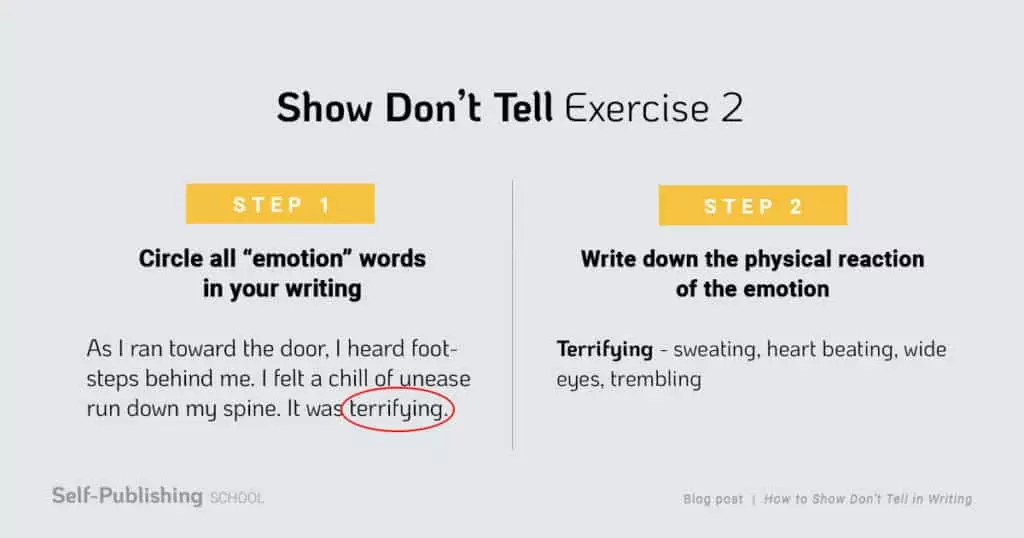
Once you have a small list for each circled word, use information technology to craft a
You tin meet the deviation lone between these two paragraphs. By replacing all of the "telling" words and phrases, information technology develops into an feel for the reader and not only a retelling of what happened.
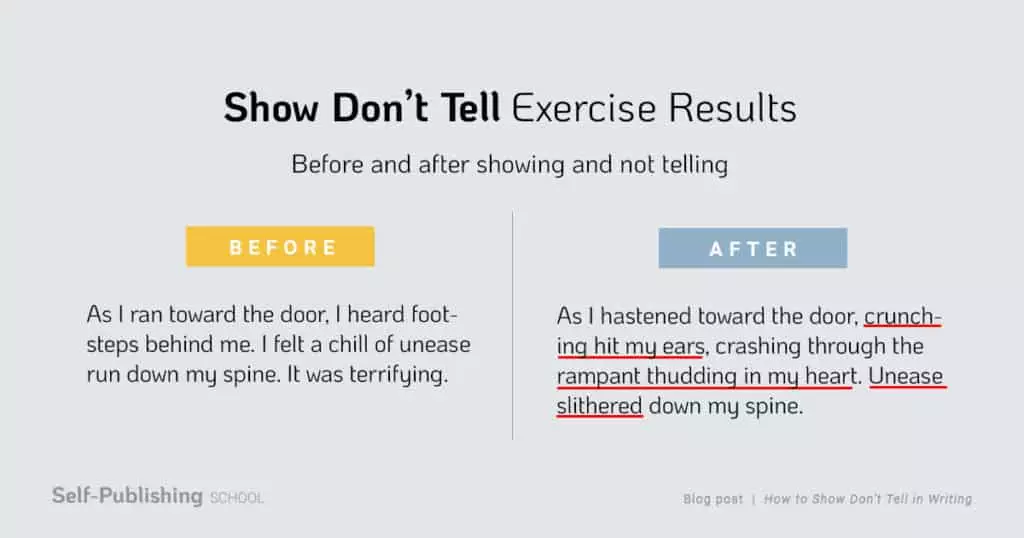
#3 – Depict body linguistic communication
Ane of the best means you can testify not tell in writing is to use stiff descriptive linguistic communication when it comes to torso language.
A person'southward actions are really a gateway to their mind and how they experience.
You lot can tell if another person has a crush on someone simply past paying attention to the way their trunk adjusts when in that person'due south presence, right?
Showing versus telling in writing is exactly that. You want to show the reader what is happening and allow them to form a decision about how you or others in your story felt based on what they expect like.
In all honesty, a lot of this i is about having religion that your audience can put 2 and two together.
Oftentimes, we tend to over-explain in an effort to make something obvious when actually, the emotion is in the guesswork; it'south in allowing someone to draw their own conclusions. That over-explaining is what comes beyond as "telly" and non as emotionally compelling.
And honestly? It's also pretty irksome and flat.
If you do a corking job of showing what you want readers to see, they'll understand how someone feels – and they'll even feel that manner themselves.
That'southward the ability of showing not telling.
#4 – Apply strong verbs
Showing itself tin be extremely impactful, but using strong language and verbs in specific situations is fifty-fifty more powerful for adding depth to your story.
The mode y'all brand someone else actually feel how you did as yous were going through the experience is to make sure the words you lot're using direct reflect the emotions .
This tin can exist a hard task for those who aren't certain what "strong linguistic communication" looks likes, simply I'll brand it easier for you.
Show Don't Tell Practise #3:
Think of a situation you want to explain in your volume (or perhaps something you lot already accept written out).
At present imagine what feeling you desire to convey through that scene. What practice you want your readers to take away from that specific moment in your story? List those emotions so y'all can see all of them.
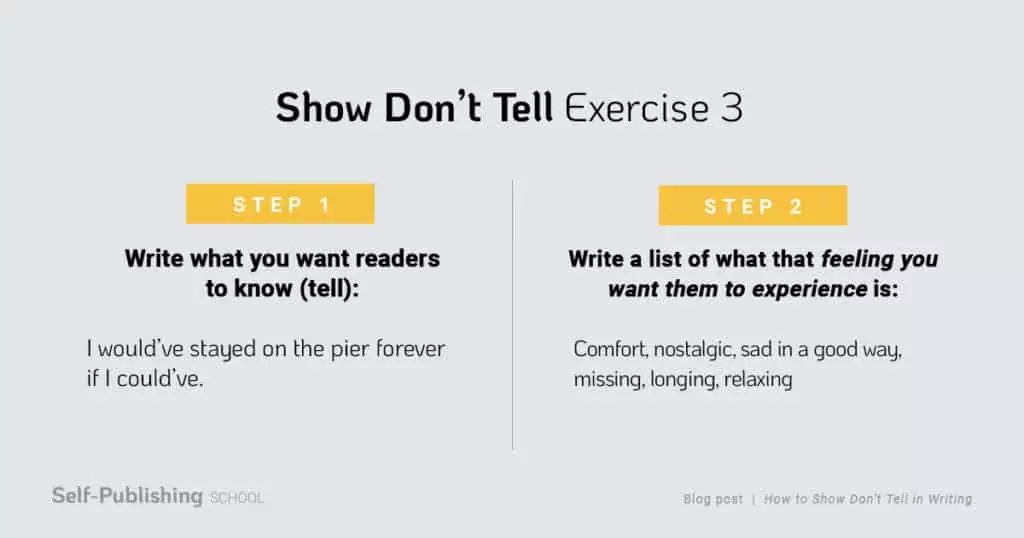
Accept that list and start writing means in which y'all can bring those emotions to life. What practise those things mean for you? How would these emotions manifest during that specific time?
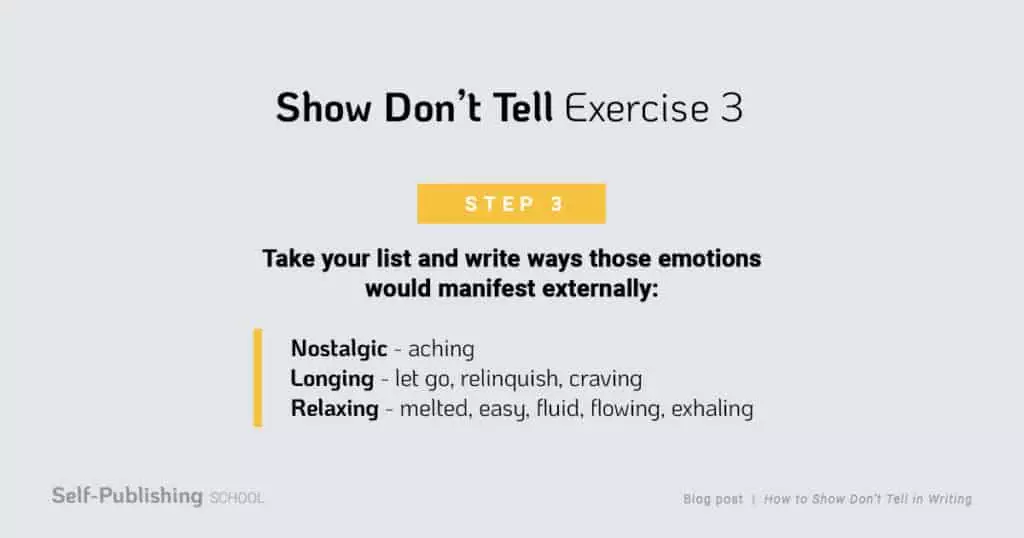
Now have those stronger verbs and words that depict a deeper emotion and craft your sentence or paragraph with those to reflect how you truly felt.
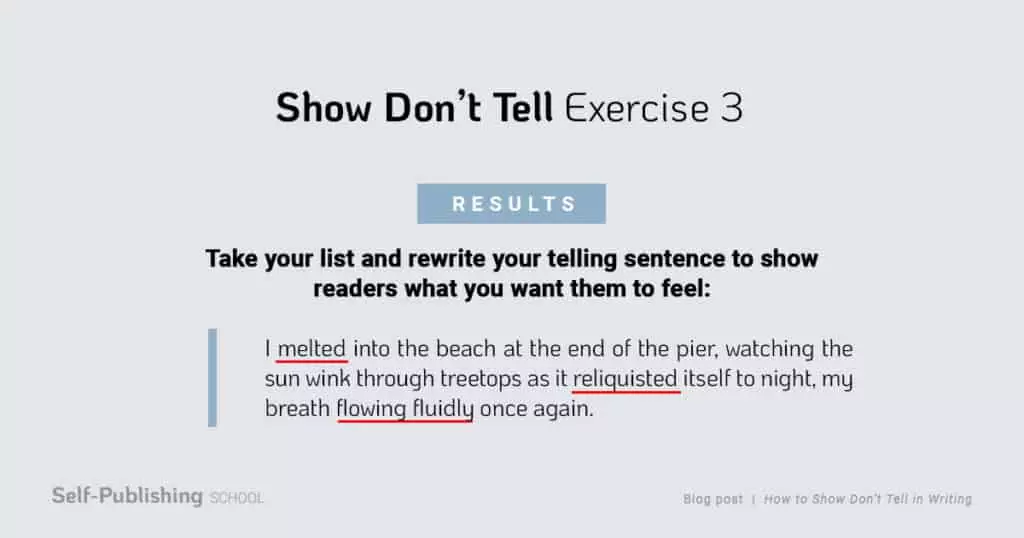
How does this sentence make y'all feel? Do you feel comfort, relaxation, and a sense that I love being there?
That was the purpose.
It's most taking one specific idea or vibe or feeling and using what you know to transform it into something that's showing not telling .
This specific example for evidence don't tell tin be a little time-consuming at starting time, but you lot will get the hang of it and these methods will soon become second nature to you.
#5 – Focus on describing senses
We told y'all to cut sensing words in tip #1, and that'south truthful, but with this comes the fact that you nonetheless have to describe what your character is feeling and sensing.
Showing versus telling is largely about allowing your readers to interpret what your characters are going through without simply telling them.
This often ways using all the senses yous can to describe a scene.
Instead of saying, "She hated information technology there." y'all can use her senses to show the readers that emotion.
For case: writing with showing like this "The faint scent of stale cigarette smoke met her nostrils, pulling her face into a familiar grimace." allows your readers to understand that she finds where she is distasteful, without having to just say and so.
#half-dozen – Practice showing not telling every day
To primary the tip of bear witness don't tell in writing, it takes time and practice to get it right. There'due south a fine line of using showing versus telling in your writing.
With regular practice (by writing every day, we suggest), you'll acquire when to use telling and when to use showing in order to give the reader the best reading feel they have.
Yous can fifty-fifty practice past reading other books and your own writing. Recognizing areas of showing tin can assist you do it more in your own works.
Disclosure: Some of the links above may contain chapter partnerships, pregnant, at no additional cost to yous, Cocky-Publishing School may earn a commission if you click through to brand a purchase.
Source: https://self-publishingschool.com/show-dont-tell-writing/
0 Response to "Once Again I Will Tell You Never Tell Me How to Type"
Post a Comment